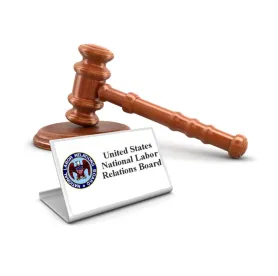On 25 August 2023, the Cemex decision by the National Labor Relations Board (NLRB or Board)1 upended 52 years of Board law that had previously enshrined the secret-ballot election as the default method for union certification. Cemex holds that employers violate Section 8(a)(5) of the National Labor Relations Act (NLRA or Act) if they decline to immediately bargain with a union, unless they file a challenging petition on one of two grounds.
Unlike prior employee-friendly decisions2 from the current NLRB that returned to Obama-era precedents, the Board in Cemex reached back some 50 years by reviving a modified version of the long-moribund Joy Silk doctrine,3 which dates back to the Truman administration. Joy Silk held that employers were required to bargain with a union unless they had a good-faith basis for doubting that the union possessed majority support among employees.
The NLRB’s holding in Cemex is nothing short of a fundamental rewrite of black-letter federal labor law that will have profound implications for unionized—and especially non-unionized—employers, which may now be deprived of opportunities to directly campaign against union representation prior to the initiation of collective bargaining.
PRE-CEMEX, EMPLOYERS COULD LEGALLY VOICE THEIR CONCERNS ABOUT UNIONS PRIOR TO A SECRET-BALLOT ELECTION WITHOUT FEAR OF AUTOMATICALLY VIOLATING THE NLRA
Before Cemex, the Board’s normal procedure for determining the proper collective bargaining representative for employees under Section 9 began when employees or a union filed a petition showing that at least 30% of employees supported a union election.
Assuming the petition was proper, employers could then either voluntarily recognize the union and begin collectively bargaining or deny recognition and insist on a secret-ballot, Board-conducted election. Crucially, pre-Cemex, employers insisting on a secret-ballot election without filing for Board relief did not violate Section 8(a)(5).4
If a majority of voting employees chose union representation, then that union would be certified by the Board and able to collectively bargain with the employer on behalf of employees.
In secret-ballot elections, employers and their agents, including employee supervisors and labor consultants, have the right (to some extent deriving from the First Amendment) in the run-up to the actual election to campaign against union representation. The employer’s right to campaign against the union was not absolute; for example, employers could not engage in coercive activity, such as threatening employees with plant closures or disciplining union leaders for their union activity, nor could they hold captive audience meetings within 24 hours of the election.
If employers did engage in unlawful conduct that constituted unfair labor practices (ULPs), then the Board possessed the power to either: (i) rerun the election; or (ii) in rare and extreme cases of employer malfeasance before, during, or after an election, issue a Gissel5 bargaining order, which then abandoned the election process and required the employer to immediately bargain with the union.
Outside exceptional circumstances warranting a Gissel bargaining order, the obligation to bargain with a union was determined after a secret-ballot election—and then only after employers had some opportunity to exercise their right under Section 8(c) of the Act to persuade employees to forgo union representation.
POST-CEMEX, EMPLOYERS CANNOT UNCONDITIONALLY INSIST ON A SECRET-BALLOT ELECTION PRIOR TO COLLECTIVE BARGAINING AND MAY BE SEVERELY LIMITED IN COUNTERING UNION NARRATIVES
The primacy of secret-ballot elections to determine whether majority support for a union exists has been the law since the mid-twentieth century. Cemex changes this time-tested process to the benefit of unions and the detriment of employers by returning to the prior essential logic of Joy Silk. It holds that an employer violates Section 8(a)(5) by not immediately recognizing and bargaining with a union—without a campaign in the run-up to a secret-ballot election—unless the employer promptly petitions the Board for relief. The Board in Cemex noted that “promptly” means employers must petition within two weeks of a union’s demand for recognition, barring “unforeseen circumstances.”
Specifically, to avoid violating Section 8(a)(5), employers must now timely file a petition for election (RM petition) under Section 9(c)(1)(B) challenging either: (i) the union’s claim of majority support among employees; or (ii) the appropriateness of the employee bargaining unit.
But even if an employer does timely file an RM petition with the Board after declining to voluntarily recognize a union, should the employer be found by the NLRB to have committed serious ULPs in the run-up to a secret-ballot election, then their RM petition will be dismissed and the Board will issue a Cemex bargaining order mandating that the employer immediately bargain with the union.
Cemex marks a dramatic shift in Board election law because it abandons the old regime under Gissel, where the NLRB would normally wait until the conclusion of a secret-ballot election to determine whether an employer’s ULPs warranted either an election re-run or Gissel bargaining order.
The Board offered several reasons for abandoning Gissel and reviving a modified version of Joy Silk. First, said the Board, employees are allegedly hurt by employer-prompted delays from insisting on a secret-ballot election because time is often of the essence in union drives. Second, opined the Board, focusing solely on employer conduct in the run-up to an initial secret-ballot election—as opposed to employer conduct before, during, and after elections, as Gissel did—is “the appropriate time period” for the NLRB to police so that employees can enjoy the “laboratory conditions” necessary for choosing union representation without employer coercion. Third, upon reviewing decades of Gissel precedent, the Board suggested that bargaining orders under the old order purportedly failed to accomplish the “twin aims of ‘effectuating ascertainable employee free choice’ and ‘deterring employer misbehavior[.]’”6
In what has been a recent pattern with the Board, the Cemex majority justified its departure from prior doctrine by pointing to old US Supreme Court decisions. In Cemex, the Board claimed that the Supreme Court’s past approval in Gissel of union authorization cards as an indicator of a union’s majority support was reason, at least in part, for abandoning the secret-ballot election as the default method for adjudicating the beginning of the collective bargaining process.7
While employers under Cemex do not need to show that they possess a subjective good-faith doubt about the union’s majority status when filing an RM petition—which is a partial departure from the original Joy Silk procedure—and are “free to seek a Board election in which the union’s majority can be tested,” if the Board finds that employers commit any ULPs that “make a fair election unlikely” then they will be ordered to immediately bargain with a union.
POST-CEMEX CONSIDERATIONS FOR EMPLOYERS FACING UNION-ORGANIZING CAMPAIGNS
The Board’s decision in Cemex is perhaps its most ambitious rewriting of federal labor law under the Biden administration, exceeding its already far-reaching jurisprudence on employer work-rules, employee abusive conduct, independent-contractor status, and non-competition agreements.8
Unlike those other decisions, Cemex has created a radically different—and thus highly unpredictable—mechanism for determining how employers can challenge union campaigns in the run-up to secret-ballot elections and when they may face mandatory bargaining orders without elections.
The Board’s modified return to the Truman-era Joy Silk doctrine creates an arguably untenable dilemma for employers. The decision to file a petition for a secret-ballot election seems straightforward, and most employers would presumably seek an election over voluntarily recognizing a union seeking to represent its employees.
Nevertheless, Cemex gives employers no guidance on what their burden of proof will be in seeking an election other than that the RM petition must challenge a union’s majority support or the appropriateness of the bargaining unit.
For example, while the Board indicated that signed union authorization cards are a good, objective indicator of a union’s majority support, there is little to suggest how an employer may counter those cards. Certainly, if employees were intimidated into signing cards, then employers will want to document and raise that concern. But employers seeking to argue generically that they have an objective good-faith basis for opposing a union’s purported majority status based on signed union authorization cards runs the risk that such an appeal will fall on deaf ears at the Board, which cited Supreme Court9 and circuit court10 precedent defending using authorization cards to determine majority status. Under the circumstances, employers without specific evidence of misconduct by the union run the risk of their RM petitions being dismissed for seemingly spurious reasons.
That said, under Cemex, at least employers do not need to prove to the Board that they have a good-faith doubt about a union’s purported majority support before promptly filing an RM petition for relief and requesting a secret-ballot election. Moreover, the Cemex majority suggested that any ULP charge against employers will not probe into an employer’s subjective beliefs about a union’s claimed majority support.
The Board further suggested in Cemex that employers can simply refuse to bargain when presented with a demand for bargaining by a union and instead litigate the matter should the union then file a ULP charge. However, the Board cautioned employers in doing so, because an employer acts “at its peril” by then running the risk of the NLRB seeking a Section 10(j) injunction against it in federal court, a possible strike by employees, and NLRA-related damages.
However, a bigger issue for employers is deciding what conduct they can engage in prior to a secret-ballot election. The NLRB did not provide a comprehensive list of employer conduct that might “make a fair election unlikely” and therefore trigger a mandatory Cemex bargaining order.
Faced with the prospect, then, that potentially any ULP charge may result in a mandatory Cemex bargaining order, employers will have to think long and hard about how exactly to campaign in the future, knowing that any misstep—no matter how insubstantial or unintentional—may result in their RM election petition being dismissed and the Board requiring them to recognize and bargain with a union.
Moreover, the results of recently concluded secret-ballot elections may also be thrown out because of Cemex. One high-profile union has already sought to capitalize on Cemex by seeking a mandatory bargaining order for alleged ULPs committed within the six-month statute of limitation set by the NLRA.11 As a result, employers that won recent secret-ballot elections, but were accused of committing ULPs in the run-up to voting, should anticipate union demands for Cemex bargaining orders.
Employer legal jeopardy post-Cemex is compounded by the Board’s recent expansion of what constitutes a ULP. Consider, for example, the Board’s recent decision in Stericycle,12 which arguably already makes it very easy for an employer to violate the NLRA in the promulgation and enforcement of facially neutral work-rules, regardless of employer intent. Enforcement of a basic violation of an employee code of conduct could result in grounds to dismiss the employer-filed election petition and a bargaining order. Similarly, an employer’s attempt to enforce a carefully constructed no solicitation/no distribution policy may now give rise to a ULP charge. Under the circumstances, an employer’s exercise of its First Amendment rights to campaign against a union could become legally akin to navigating a minefield.
Ultimately, assuming Cemex survives judicial review after it is inevitably challenged, employers in this tight labor market face an emboldened Board bent on fundamentally altering NLRA law in an employee-friendly direction that could further encourage union-organizing campaigns—and victories, especially if the Board liberally imposes Cemex bargaining orders that bypass the secret-ballot election.




 />i
/>i

